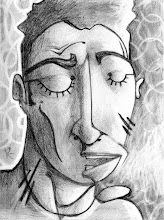



"Much of the art of earliest peoples: signs and marks on pottery, textiles and inscriptions and paintings on rock were simple, geometric and linear forms which might reveal a symbolic or decorative purpose. It is at this level of visual meaning that abstract art communicates. One can enjoy the beauty of Chinese or Islamic calligraphy without being able to read it.
In 1913 the poet Guillaume Appollinaire named the work of Robert and Sonia Delaunay, Orphism. He defined it as, the art of painting new structures out of elements that have not been borrowed from the visual sphere, but had been created entirely by the artist...it is a pure art.
Some approaches towards abstract art drew connections to music. Music provides an example of an art form which uses the abstract elements of sound and divisions of time. Wassily Kandinsky, himself a musician, was inspired by the possibility of marks and associative color resounding in the soul. The idea had been put forward by Charles Baudelaire, that all our senses respond to various stimuli but the senses are connected at a deeper aesthetic level.
Closely related to this, is the idea that art has The spiritual dimension and can transcend 'every-day' experience, reaching a spiritual plane. The Theosophical Society popularised the ancient wisdom of the sacred books of India, China in the early years of the century. It was in this context that Piet Mondrian, Wassily Kandinsky, Hilma af Klint and other artists working towards an 'objectless state' became interested in the occult as a way of creating an 'inner' object. The universal and timeless shapes found in Geometry: the circle, square and triangle become the spacial elements in abstract art; they are, like color, fundamental systems underlying visible reality."
--Collected Wikipedia words which say what I would say, but more smoothly and with less effort on my part. I can say without ego, that I am a quite lazy man (in those worlds outside of the arts).

No comments:
Post a Comment